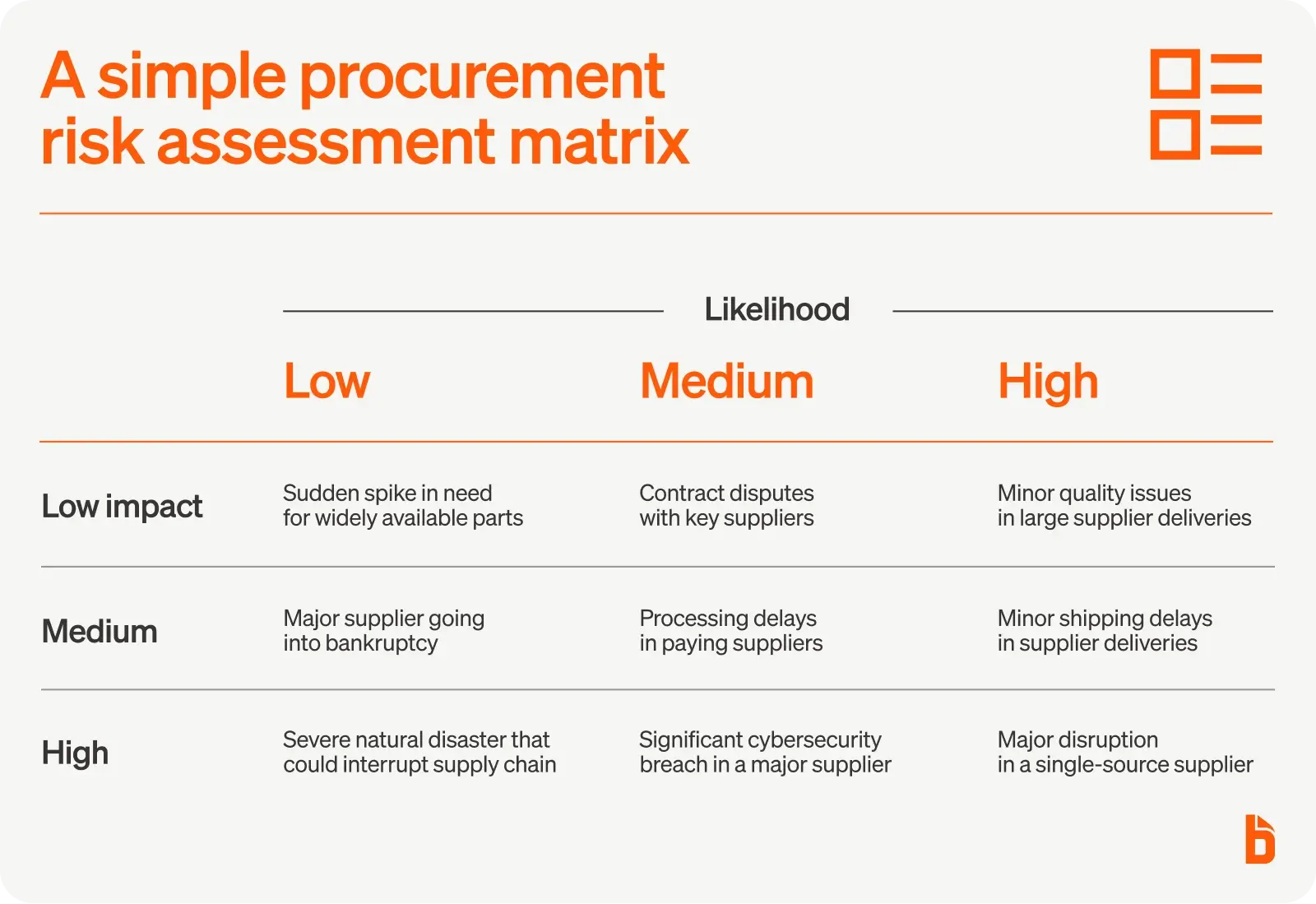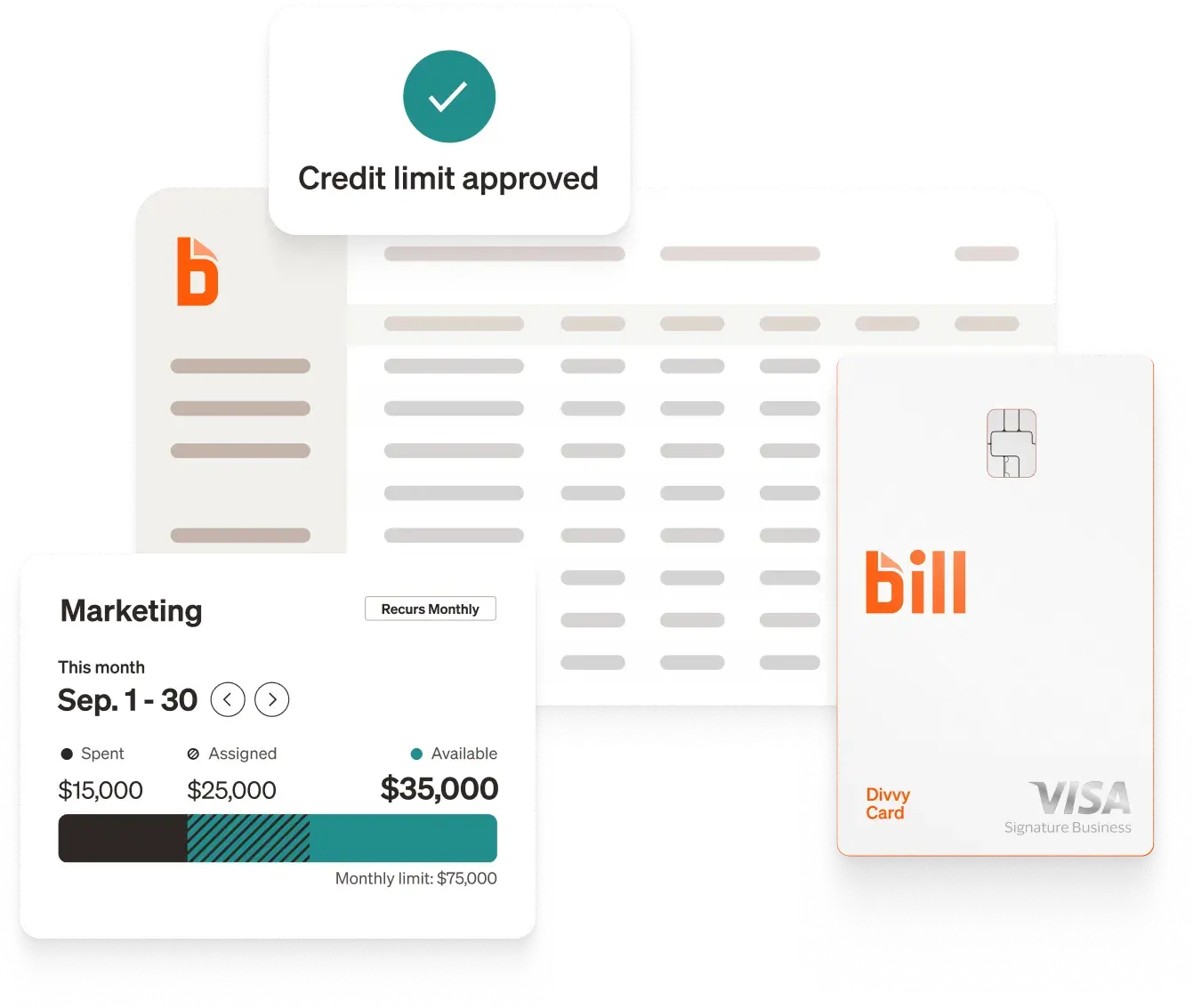Smart procurement teams don't just manage suppliers—they work proactively to minimize the risks that can interrupt supply. This article walks through the most common procurement risks, offering proven strategies to minimize their impact on your operations and bottom line.
What are procurement risks?
Procurement risks are potential threats that can disrupt your ability to acquire goods and services effectively. These risks emerge from supplier relationships, market conditions, internal processes, and external factors beyond your direct control.
When unmanaged, they can lead to cost overruns, operational disruptions, quality issues, and damaged stakeholder relationships.
Sources of risk in procurement
Procurement risks originate from four main areas:
- Supplier factors, like financial instability or capacity constraints
- Procurement process issues, such as inadequate controls or poor planning
- Market dynamics, including price volatility and material shortages
- Compliance challenges, from regulatory changes to contractual disputes
The first step in effective procurement risk management is systematically considering each of these potential sources and actively monitoring for early warning signs.
Importance of procurement risk management
Effective procurement risk management protects your organization's financial health by preventing cost overruns and ensuring predictable cash flow. It also maintains business continuity by securing reliable access to critical goods and services, while preserving customer relationships through consistent quality and delivery.
Beyond risk mitigation, strong procurement risk management creates competitive advantages by fostering better supplier negotiations, faster decision-making, and more strategic resource allocation.
Procurement risk assessment matrix
A risk assessment matrix helps procurement teams systematically evaluate threats based on their likelihood and potential impact, creating a visual framework for prioritizing mitigation efforts. This structured approach ensures resources focus on the highest-priority risks while maintaining awareness of emerging threats that require monitoring.
Here's what a simple procurement risk assessment matrix looks like:

Risks that have a high likelihood and a high potential impact require a comprehensive mitigation plan and close monitoring, while risks with a low likelihood and low risk may need only basic monitoring.
8 common procurement risks
While every organization faces unique challenges, these eight potential risks represent some of the most significant threats that procurement teams must address to manage procurement risks effectively and protect operations and financial performance.
1. Supplier dependency and single-source risks
Over-reliance on a single supplier can leave your team vulnerable to supply disruptions. The more power a single supplier has to interrupt your operations, the more danger there is of falling victim to price manipulation and draconian contract negotiations.
How to address it: Diversify your supplier base by qualifying multiple vendors for critical categories, establishing backup suppliers with pre-negotiated agreements, and monitoring supplier performance to identify risks early. Create contingency plans that include alternative sourcing options, inventory buffers for critical items, and clear protocols for rapidly activating backup suppliers when primary relationships fail.
2. General supply chain disruption risks
Natural disasters, geopolitical tensions, transportation breakdowns, and economic upheaval can shut down your supply chains without warning. When key suppliers suddenly can't deliver, your operations can grind to a halt while competitors with better contingency plans keep running.
How to address it: Map your supply chain to understand where it might be vulnerable. If your suppliers are in the same area, they might all get their materials from the same place! Develop alternative sourcing strategies across different geographic regions, and maintain strategic inventory levels for your most important parts and supplies. Finally, make sure your protocols include clear plans for rapid response in case of emergency.
3. Financial and credit risks
When suppliers face financial trouble, you often don't find out until deliveries stop or quality drops dramatically. Supplier bankruptcies can leave you with unfinished orders and lost deposits as you scramble to find last-minute replacements at premium prices.
How to address it: Check up on the financial health of key suppliers regularly using credit reports, financial statements, and industry benchmarks, and maintain diverse supplier portfolios to reduce concentration risk. Also, watch for trends in things like rising delivery times or quality issues. These early warning systems can detect signs of financial distress before it becomes a crisis.
4. Quality and compliance risks
Substandard parts & supplies can slow or even stall your operations, and that's if they're caught before they enter your production line. If they aren't, the consequences can range from customer complaints to costly recalls or even regulatory violations.
How to address it: Minimizing this supply chain risk often comes down to contract management. Establish clear quality specifications in contracts, implement incoming inspections, and conduct regular supplier audits to verify that deliveries are meeting your standards. Set up policies and procedures to address quality issues quickly while maintaining supplier relationships.
5. Cybersecurity and data protection risks
Cyber attacks targeting your suppliers can expose your sensitive business information, disrupt operations, and create compliance headaches. Depending on the data that's stolen and the nature of your connection, you could even be vulnerable to direct hacks or fraud.
How to address it: Assess cybersecurity for key suppliers before you sign on the dotted line. For the ones you approve, be sure to establish secure communication channels for sensitive information, and review their SOC 2 report and other security documentation on a regular basis.
6. Contract and legal risks
Poorly written contracts create loopholes that suppliers can exploit, while unclear terms lead to disputes that drain time and money. Unfortunately, inadequate legal protections for everything from liability to intellectual property rights can result in potentially catastrophic losses, with litigation that drags on for years.
How to address it: Engage legal expertise during the contract development phase, and work closely with your legal team to make sure they understand your business needs. That will help them clearly define deliverables, timelines, and performance standards, as well as including appropriate clauses for risk allocation.
7. Reputation and ethical risks
Supplier scandals can do a real number on your brand reputation, especially if customers hold you accountable. Given today's cancel culture, questionable labor practices, environmental violations, or other issues at supplier facilities can trigger a social media nightmare.
How to address it: Implement ethical screening during supplier selection, establishing codes of conduct that suppliers need to acknowledge and follow. Then, create monitoring systems to keep an eye out for potential ethical issues. And, just in case, develop general response protocols that include communication strategies, corrective action plans, and supplier relationship management approaches that balance accountability with business continuity.
8. Manual procurement processes
From inefficient contract management to slow business processes that gum up the works, manual processes in procurement business operations can escalate risk significantly—especially if you're trying to manage global supply chains. You'll have enough of a challenge managing external risks and supply chain issues without adding your own inefficiencies to the mix.
How to address it: Today's procurement leaders are saying goodbye to manual data entry and poor contract management, and implementing digital procurement platforms for real-time vendor management and risk analysis. A modern AI-enabled system can be one of the best procurement strategies for uncovering poor supplier performance, minimizing risk factors, and improving supplier reliability.
Mitigate procurement risks with BILL Procurement
If you'd like to reduce risk and increase control of your procure-to-pay process, BILL Procurement delivers better visibility and control of spend so you can make purchasing and payment decisions with confidence.
BILL Procurement streamlines your procure-to-pay workflows from a single, easy-to-use workspace, using powerful automation to make traditionally complex work simple.
From purchase request creation and approval, to sending purchase orders, invoice intake and matching, to payment and reconciliation, BILL Procurement can help your team slash tedious, manual work. Take a live demo to see how it works.








